Direct Numerical Simulation of Water Droplets in Turbulent Flow
Abstract
1. Introduction
1.1. Flow over a Spherical Particle
1.2. Hydrodynamics of Raindrops
1.3. Drag Coefficients and Terminal Velocities of Water Drops
2. Numerical Methods
3. Computational Setup
4. Results
4.1. Terminal Velocity
4.2. Drop Shape Deformation and Drop Oscillation
4.3. Flow Field
4.3.1. Instantaneous Flow
4.3.2. Mean Flow Parameters
4.4. Internal Circulation
5. Conclusions
Author Contributions
Funding
Acknowledgments
Conflicts of Interest
Abbreviations
| terminal velocity | () | |
| DNS | Direct Numerical Simulation | |
| FS3D | Free Surface 3D | |
| MAC | Marker and Cell | |
| VOF | volume of fluid method | |
| PLIC | Piecewise Linear Interface Calculation | |
| ∇ | Nabla-Operator | |
| turbulent kinetic energy | (−) | |
| D | equivalent droplet diameter | () |
| drag coefficient | (−) | |
| density | () | |
| f | volume fraction variable | (−) |
| separation angle | () | |
| Re | Reynolds number | |
| St | Strouhal number | |
| We | Weber number | |
| velocity vector | () | |
| t | time | () |
| p | pressure | () |
| dynamic viscosity | () | |
| gravitational acceleration | () | |
| surface tension force | () | |
| l | liquid phase | |
| gas phase | ||
| normal vector at the interface | (−) | |
| CFL | Courant–Friedrich–Lewy | |
| surface tension | ||
| turbulence intensity | (−) | |
| turbulence length scale | () | |
| cell size | () | |
| Kolmogorov length scale | () | |
| streamwise velocity fluctuations | () | |
| transverse velocity fluctuations | () | |
| spanwise velocity fluctuations | () | |
| a | semi-major axis length, measured in y-direction | () |
| semi-major axis length, measured in z-direction | () | |
| b | semi-minor axis length | () |
| drop surface area | () | |
| surface area of a sphere | () | |
| time-averaged length of semi-major axis | () | |
| base suction coefficient | (−) | |
| vorticity magnitude | () | |
| pressure coefficient | (−) | |
| time-averaged flow separation angle | () | |
| time average | ||
| L | length of the recirculation region | () |
| minimum pressure coefficient on the wake axis | (−) | |
| vortex formation length | () |
Appendix A. Studies for Grid Resolution and Domain Size
| Test Series | Grid-Cells in a Drop Diameter | Domain Width | Wake Length | Drop Position | Case Number |
|---|---|---|---|---|---|
| Grid Resolution | 13.3 | 7.2D | 10.8D | 3.6D | a1 |
| 15.6 | a2 | ||||
| 18.3 | a3 | ||||
| 26.7 | a4 | ||||
| Wake Length | 26.7 | 7.2D | 10.8D | 3.6D | b1 |
| 15.6D | b2 | ||||
| 20.4D | b3 | ||||
| 24.4D | b4 | ||||
| Domain Width | 26.7 | 7.2D | 18D | 6.0D | c1 |
| 12.0D | c2 | ||||
| 16.8D | c3 | ||||
| Drop Centre in the Stream-wise Direction | 26.7 | 12D | 15.6D | 3.6D | d1 |
| 6.0D | d2 | ||||
| 8.4D | d3 | ||||
| 10.8D | d4 |
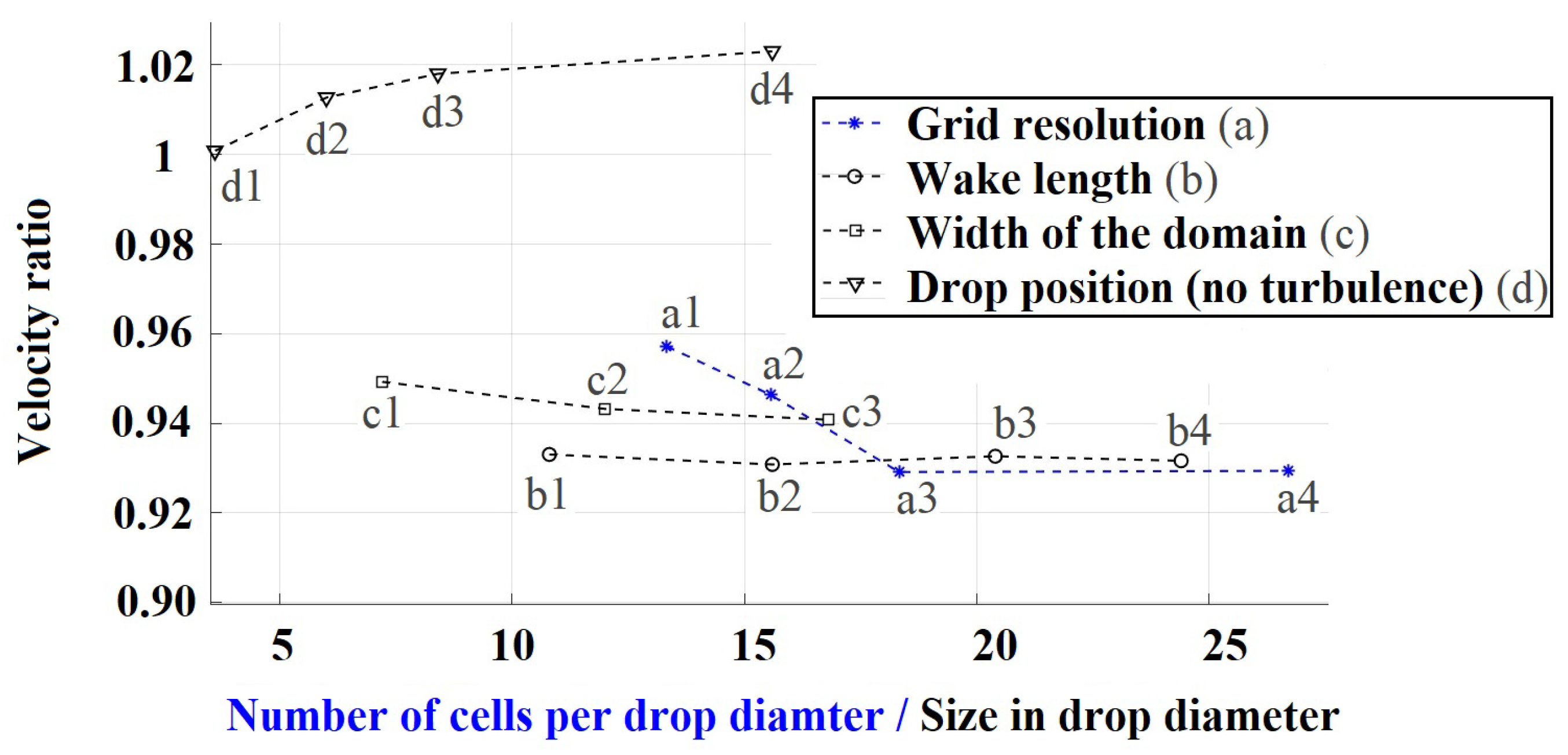
Appendix B. Validations for the Drop Deformation

References
- Hosking, J.; Stow, C. Ground-based measurements of raindrop fallspeeds. J. Atmos. Ocean. Technol. 1991, 8, 137–147. [Google Scholar] [CrossRef]
- Sekhon, R.; Srivastava, R. Doppler radar observations of drop-size distributions in a thunderstorm. J. Atmos. Sci. 1971, 28, 983–994. [Google Scholar] [CrossRef]
- Pei, B.; Testik, F.; Gebremichael, M. Impacts of raindrop fall velocity and axis ratio errors on dual-polarization radar rainfall estimation. J. Hydrometeorol. 2014, 15, 1849–1861. [Google Scholar] [CrossRef]
- Joss, J.; Waldvogel, A. Ein spektrograph für niederschlagstropfen mit automatischer auswertung. Pure Appl. Geophys. 1967, 68, 240–246. [Google Scholar] [CrossRef]
- Marshall, J.; Langille, R.; Palmer, W.M.K. Measurement of rainfall by radar. J. Meteorol. 1947, 4, 186–192. [Google Scholar] [CrossRef]
- List, R.; Donaldson, N.; Stewart, R. Temporal evolution of drop spectra to collisional equilibrium in steady and pulsating rain. J. Atmos. Sci. 1987, 44, 362–372. [Google Scholar] [CrossRef]
- Fornis, R.; Vermeulen, H.; Nieuwenhuis, J. Kinetic energy–rainfall intensity relationship for Central Cebu, Philippines for soil erosion studies. J. Hydrol. 2005, 300, 20–32. [Google Scholar] [CrossRef]
- Rosewell, C. Rainfall kinetic energy in eastern Australia. J. Clim. Appl. Meteorol. 1986, 25, 1695–1701. [Google Scholar] [CrossRef]
- Fox, N. The representation of rainfall drop-size distribution and kinetic energy. Hydrol. Earth Syst. Sci. Discuss. 2004, 8, 1001–1007. [Google Scholar] [CrossRef]
- Panagopoulos, A.; Kanellopoulos, J. Prediction of triple-orbital diversity performance in Earth-space communication. Int. J. Satell. Commun. 2002, 20, 187–200. [Google Scholar] [CrossRef]
- Gunn, R.; Kinzer, G. The terminal velocity of fall for water droplets in stagnant air. J. Meteorol. 1949, 6, 243–248. [Google Scholar] [CrossRef]
- Löffler-Mang, M.; Joss, J. An optical disdrometer for measuring size and velocity of hydrometeors. J. Atmos. Ocean. Technol. 2000, 17, 130–139. [Google Scholar] [CrossRef]
- Testik, F.; Barros, A.; Bliven, L. Field observations of multimode raindrop oscillations by high-speed imaging. J. Atmos. Sci. 2006, 63, 2663–2668. [Google Scholar] [CrossRef]
- Montero-Martínez, G.; Kostinski, A.; Shaw, R.; García-García, F. Do all raindrops fall at terminal speed? Geophys. Res. Lett. 2009, 36. [Google Scholar] [CrossRef]
- Larsen, M.; Kostinski, A.; Jameson, A. Further evidence for superterminal raindrops. Geophys. Res. Lett. 2014, 41, 6914–6918. [Google Scholar] [CrossRef]
- Montero-Martínez, G.; García-García, F. On the behaviour of raindrop fall speed due to wind. Q. J. R. Meteorol. Soc. 2016, 142, 2013–2020. [Google Scholar] [CrossRef]
- Niu, S.; Jia, X.; Sang, J.; Liu, X.; Lu, C.; Liu, Y. Distributions of raindrop sizes and fall velocities in a semiarid plateau climate: Convective versus stratiform rains. J. Appl. Meteorol. Climatol. 2010, 49, 632–645. [Google Scholar] [CrossRef]
- Thurai, M.; Bringi, V.; Petersen, W.; Gatlin, P. Drop shapes and fall speeds in rain: Two contrasting examples. J. Appl. Meteorol. Climatol. 2013, 52, 2567–2581. [Google Scholar] [CrossRef]
- Bringi, V.; Thurai, M.; Baumgardner, D. Raindrop fall velocities from an optical array probe and 2-D video disdrometer. Atmos. Meas. Technol. 2018, 11, 1377–1384. [Google Scholar] [CrossRef]
- Stout, J.; Arya, S.; Genikhovich, E. The effect of nonlinear drag on the motion and settling velocity of heavy particles. J. Atmos. Sci. 1995, 52, 3836–3848. [Google Scholar] [CrossRef]
- Smith, F. Conditioned particle motion in a homogeneous turbulent field. Atmos. Environ. (1967) 1968, 2, 491–508. [Google Scholar] [CrossRef]
- Clift, R.; Grace, J.; Weber, M. Bubbles, Drops, and Particles; Courier Corporation: Chelmsford, MA, USA, 2005. [Google Scholar]
- Johnson, T.; Patel, V. Flow past a sphere up to a Reynolds number of 300. J. Fluid Mech. 1999, 378, 19–70. [Google Scholar] [CrossRef]
- Sakamoto, H.; Haniu, H. A study on vortex shedding from spheres in a uniform flow. J. Fluids Eng. 1990, 112, 386–392. [Google Scholar] [CrossRef]
- Leweke, T.; Provansal, M.; Ormieres, D.; Lebescond, R. Vortex dynamics in the wake of a sphere. Phys. Fluids 1999, 11, S12. [Google Scholar] [CrossRef]
- Mittal, R. Planar symmetry in the unsteady wake of a sphere. AIAA J. 1999, 37, 388–390. [Google Scholar] [CrossRef]
- Kim, H.; Durbin, P. Observations of the frequencies in a sphere wake and of drag increase by acoustic excitation. Phys. Fluids 1988, 31, 3260–3265. [Google Scholar] [CrossRef]
- Yun, G.; Kim, D.; Choi, H. Vortical structures behind a sphere at subcritical Reynolds numbers. Phys. Fluids 2006, 18, 015102. [Google Scholar] [CrossRef]
- Van Dyke, M. An Album of Fluid Motion; Parabolic Press: Stanford, CA, USA, 1982. [Google Scholar]
- Szakáll, M.; Mitra, S.; Diehl, K.; Borrmann, S. Shapes and oscillations of falling raindrops—A review. Atmos. Res. 2010, 97, 416–425. [Google Scholar] [CrossRef]
- Beard, K. Terminal velocity and shape of cloud and precipitation drops aloft. J. Atmos. Sci. 1976, 33, 851–864. [Google Scholar] [CrossRef]
- Pruppacher, H.; Klett, J. Microphysics of Clouds and Precipitation, 2nd ed.; Kulwer Academic: Dordrecht, The Netherlands, 1997. [Google Scholar]
- Tokay, A.; Beard, K. A field study of raindrop oscillations. Part I: Observation of size spectra and evaluation of oscillation causes. J. Appl. Meteorol. 1996, 35, 1671–1687. [Google Scholar] [CrossRef]
- Pruppacher, H.; Beard, K. A wind tunnel investigation of the internal circulation and shape of water drops falling at terminal velocity in air. Q. J. R. Meteorol. Soc. 1970, 96, 247–256. [Google Scholar] [CrossRef]
- LeClair, B.; Hamielec, A.; Pruppacher, H.; Hall, W. A theoretical and experimental study of the internal circulation in water drops falling at terminal velocity in air. J. Atmos. Sci. 1972, 29, 728–740. [Google Scholar] [CrossRef]
- Szakáll, M.; Diehl, K.; Mitra, S.; Borrmann, S. A wind tunnel study on the shape, oscillation, and internal circulation of large raindrops with sizes between 2.5 and 7.5 mm. J. Atmos. Sci. 2009, 66, 755–765. [Google Scholar] [CrossRef]
- Eisenschmidt, K.; Ertl, M.; Gomaa, H.; Kieffer-Roth, C.; Meister, C.; Rauschenberger, P.; Reitzle, M.; Schlottke, K.; Weigand, B. Direct numerical simulations for multiphase flows: An overview of the multiphase code FS3D. Appl. Mathe. Comput. 2016, 272, 508–517. [Google Scholar] [CrossRef]
- Hirt, C.; Nichols, B. Volume of fluid (VOF) method for the dynamics of free boundaries. J. Comput. Phys. 1981, 39, 201–225. [Google Scholar] [CrossRef]
- Rider, W.J.; Kothe, D.B. Reconstructing volume tracking. J. Comput. Phys. 1998, 141, 112–152. [Google Scholar] [CrossRef]
- Popinet, S. An accurate adaptive solver for surface-tension-driven interfacial flows. J. Comput. Phys. 2009, 228, 5838–5866. [Google Scholar] [CrossRef]
- Rieber, M. Numerische Modellierung der Dynamik freier Grenzflächen in Zweiphasenströmungen. Ph.D. Thesis, University of Stuttgart, Stuttgart, Germany, 2004. [Google Scholar] [CrossRef]
- Harlow, F.; Welch, J. Numerical calculation of time-dependent viscous incompressible flow of fluid with free surface. Phys. Fluids 1965, 8, 2182–2189. [Google Scholar] [CrossRef]
- Kornev, N.; Hassel, E. Synthesis of homogeneous anisotropic divergence-free turbulent fields with prescribed second-order statistics by vortex dipoles. Phys. Fluids 2007, 19, 068101. [Google Scholar] [CrossRef]
- Zhu, C.; Ertl, M.; Weigand, B. Numerical investigation on the primary breakup of an inelastic non-Newtonian liquid jet with inflow turbulence. Phys. Fluids 2013, 25, 083102. [Google Scholar] [CrossRef]
- Baggio, M.; Weigand, B. Numerical simulation of a drop impact on a superhydrophobic surface with a wire. Phys. Fluids 2019, 31, 112107. [Google Scholar] [CrossRef]
- Tomboulides, A.; Orszag, S. Numerical investigation of transitional and weak turbulent flow past a sphere. J. Fluid Mech. 2000, 416, 45–73. [Google Scholar] [CrossRef]
- Wu, J.; Faeth, G. Sphere wakes in still surroundings at intermediate Reynolds numbers. AIAA J. 1993, 31, 1448–1455. [Google Scholar] [CrossRef]
- Rodriguez, I.; Borrell, R.; Lehmkuhl, O.; Segarra, C.; Oliva, A. Direct numerical simulation of the flow over a sphere at Re = 3700. J. Fluid Mech. 2011, 679, 263–287. [Google Scholar] [CrossRef]
- Magarvey, R.; Bishop, R. Wakes in liquid-liquid systems. Phys. Fluids 1961, 4, 800–805. [Google Scholar] [CrossRef]
- Poon, E.; Iaccarino, G.; Ooi, A.S.; Giacobello, M. Numerical studies of high Reynolds number flow past a stationary and rotating sphere. In Proceedings of the 7th International Conference on CFD in the Minerals and Process Industries, Melbourne, Australia, 9–11 December 2009. [Google Scholar]
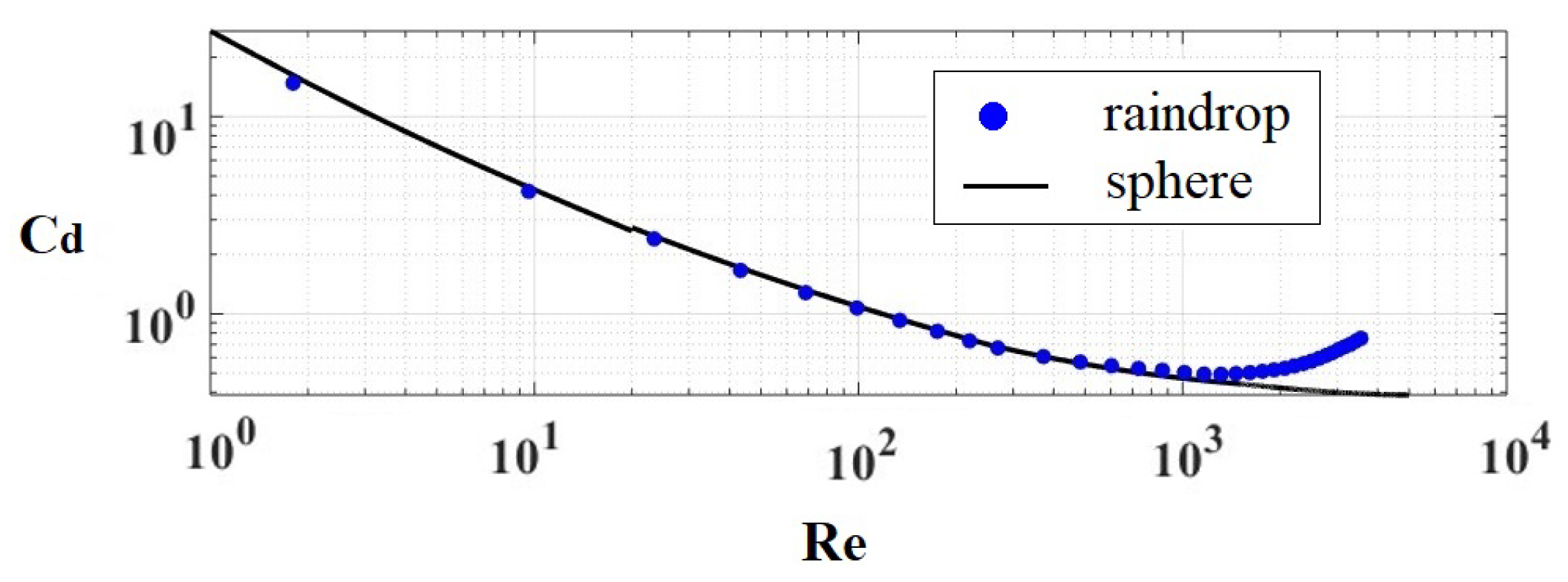
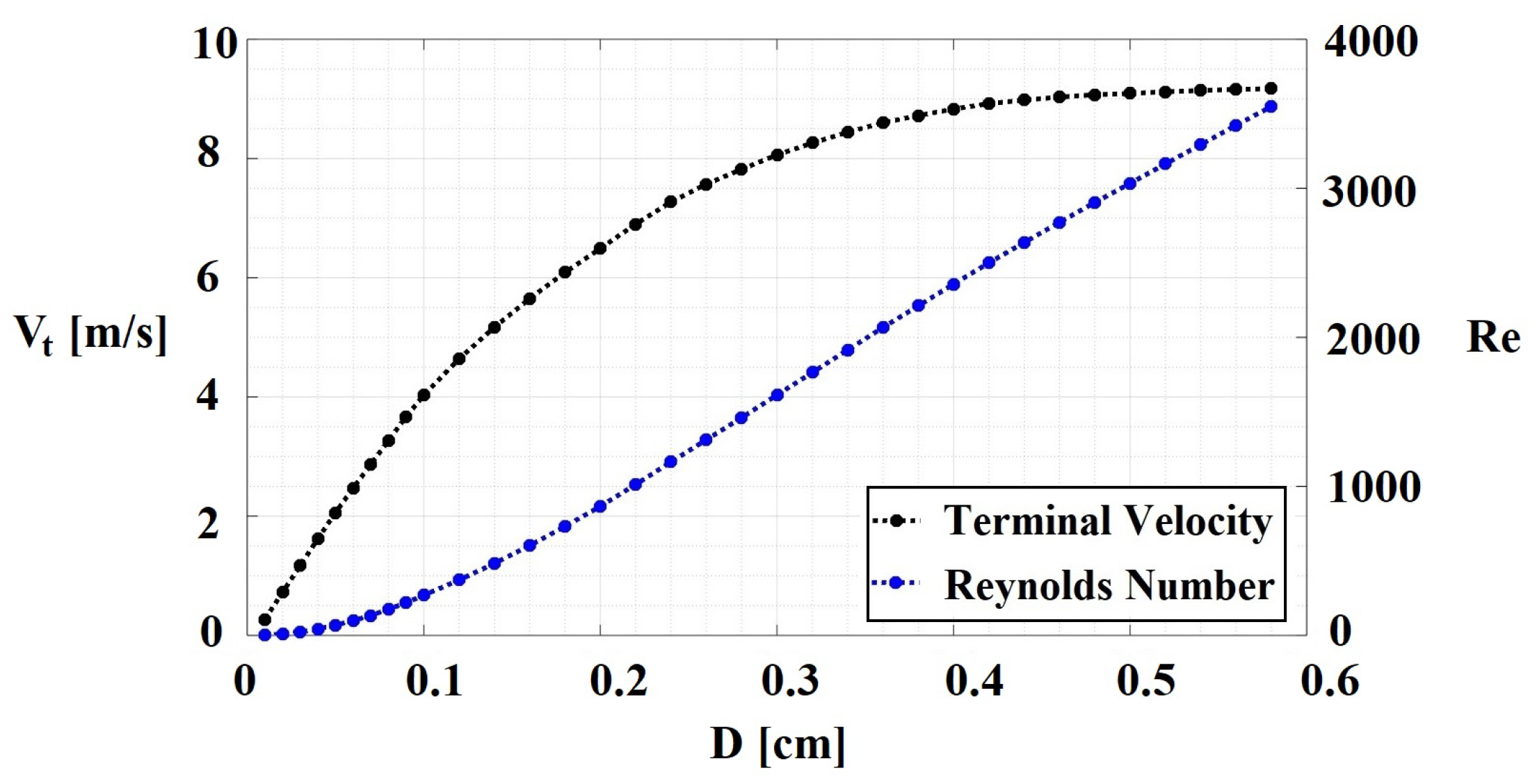
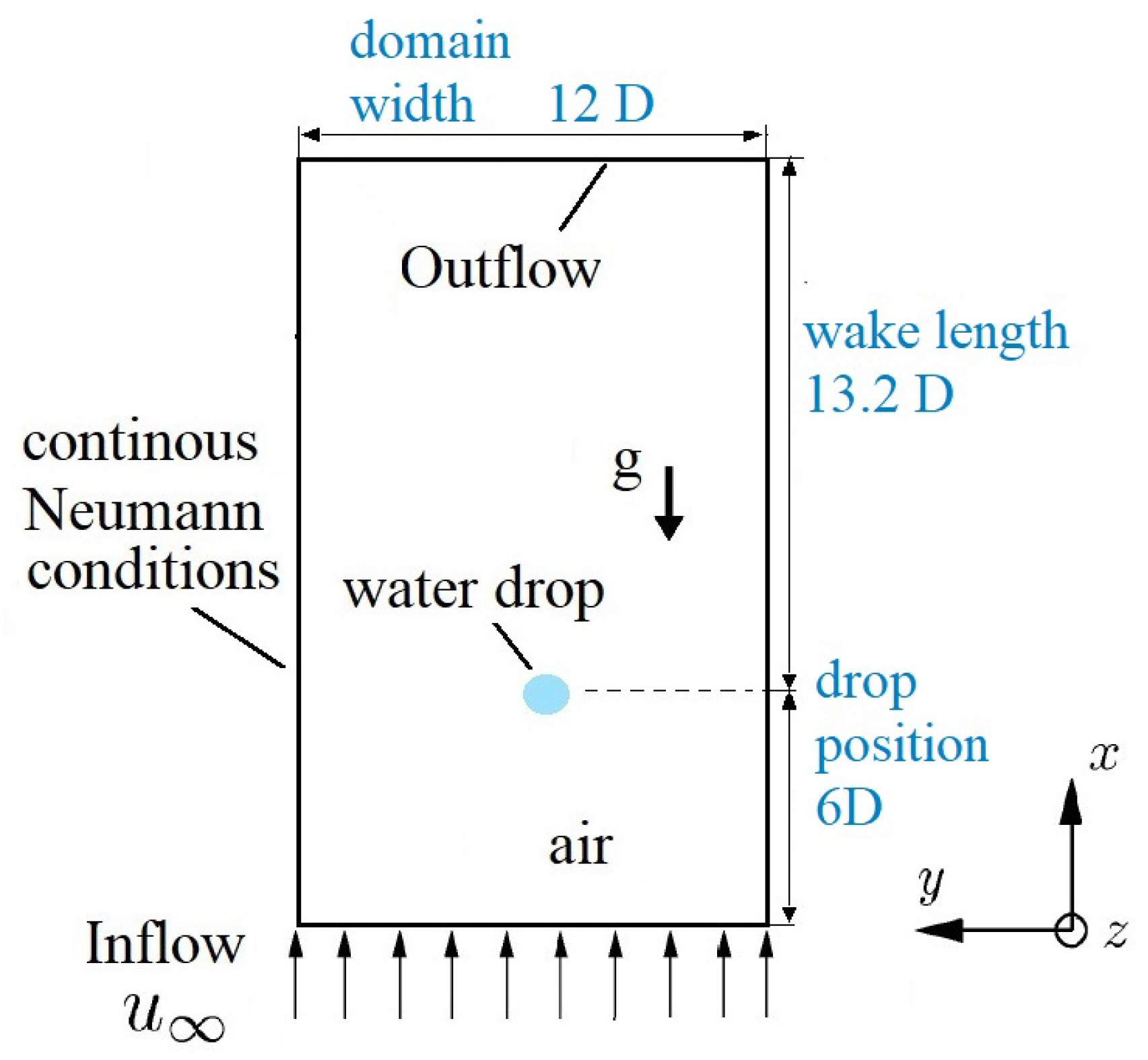
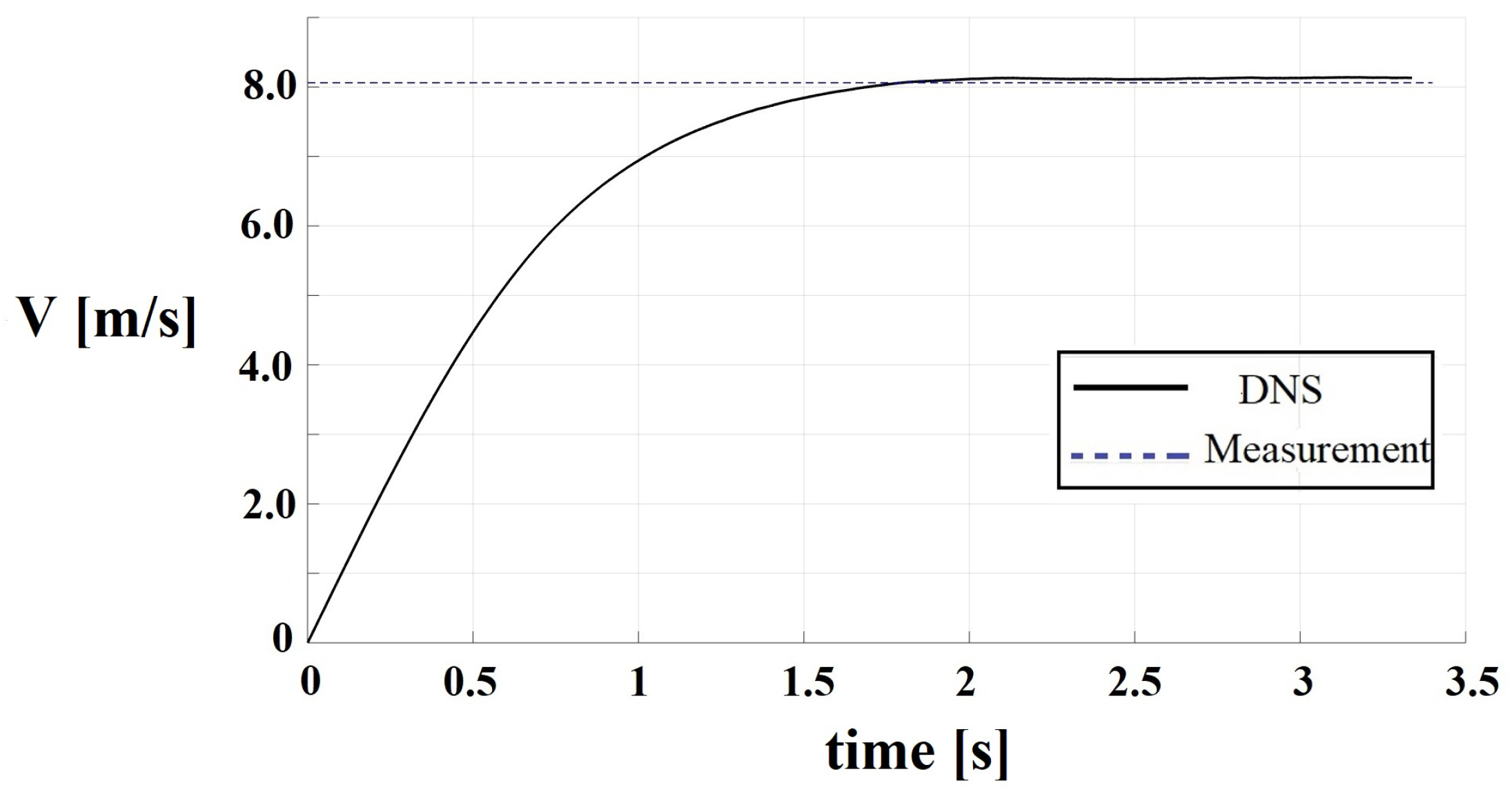

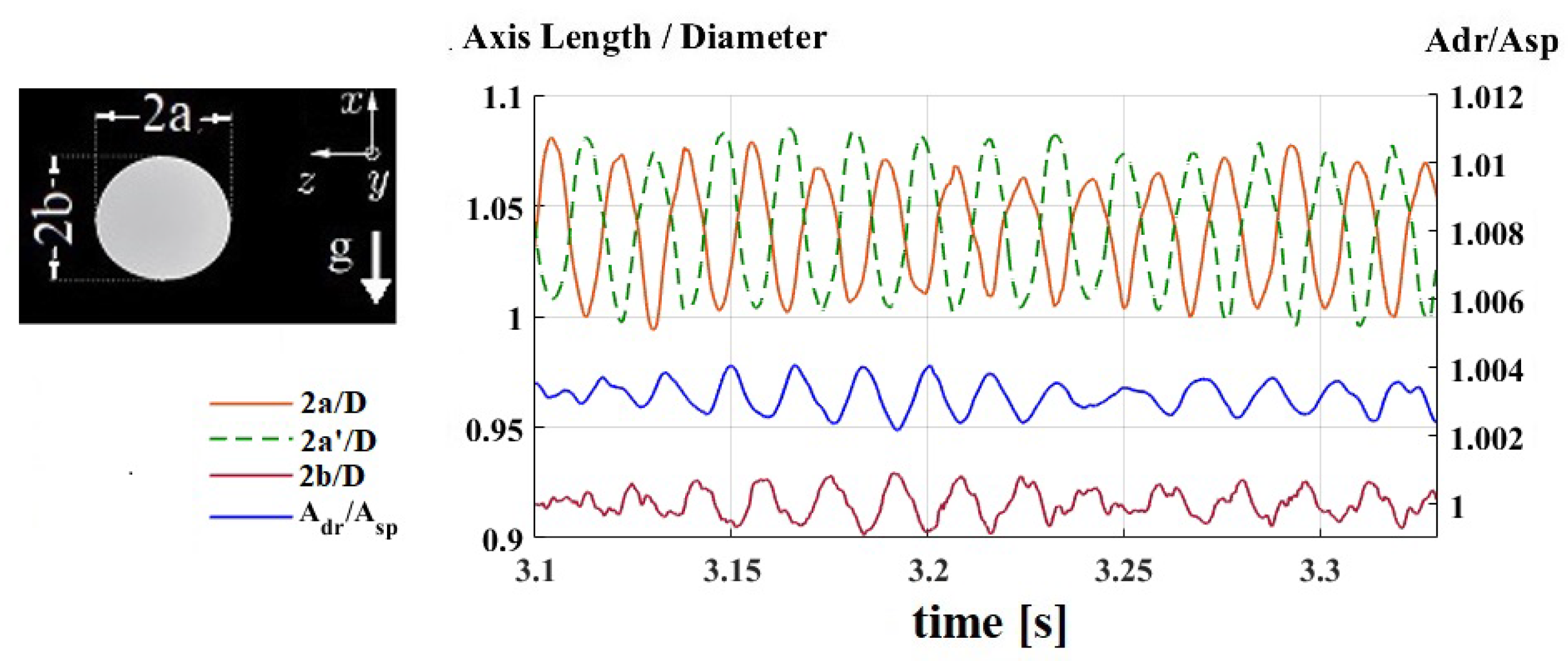

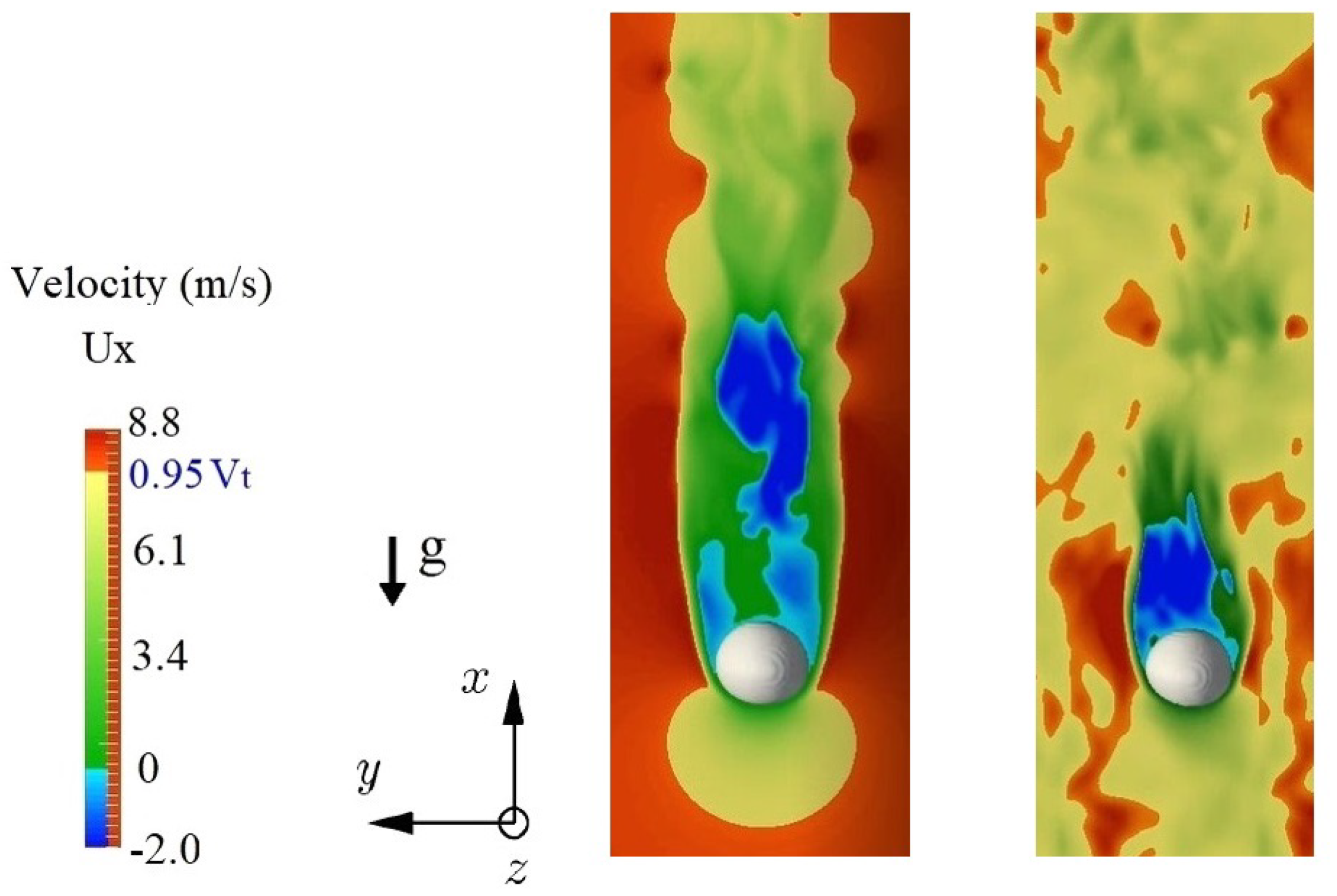
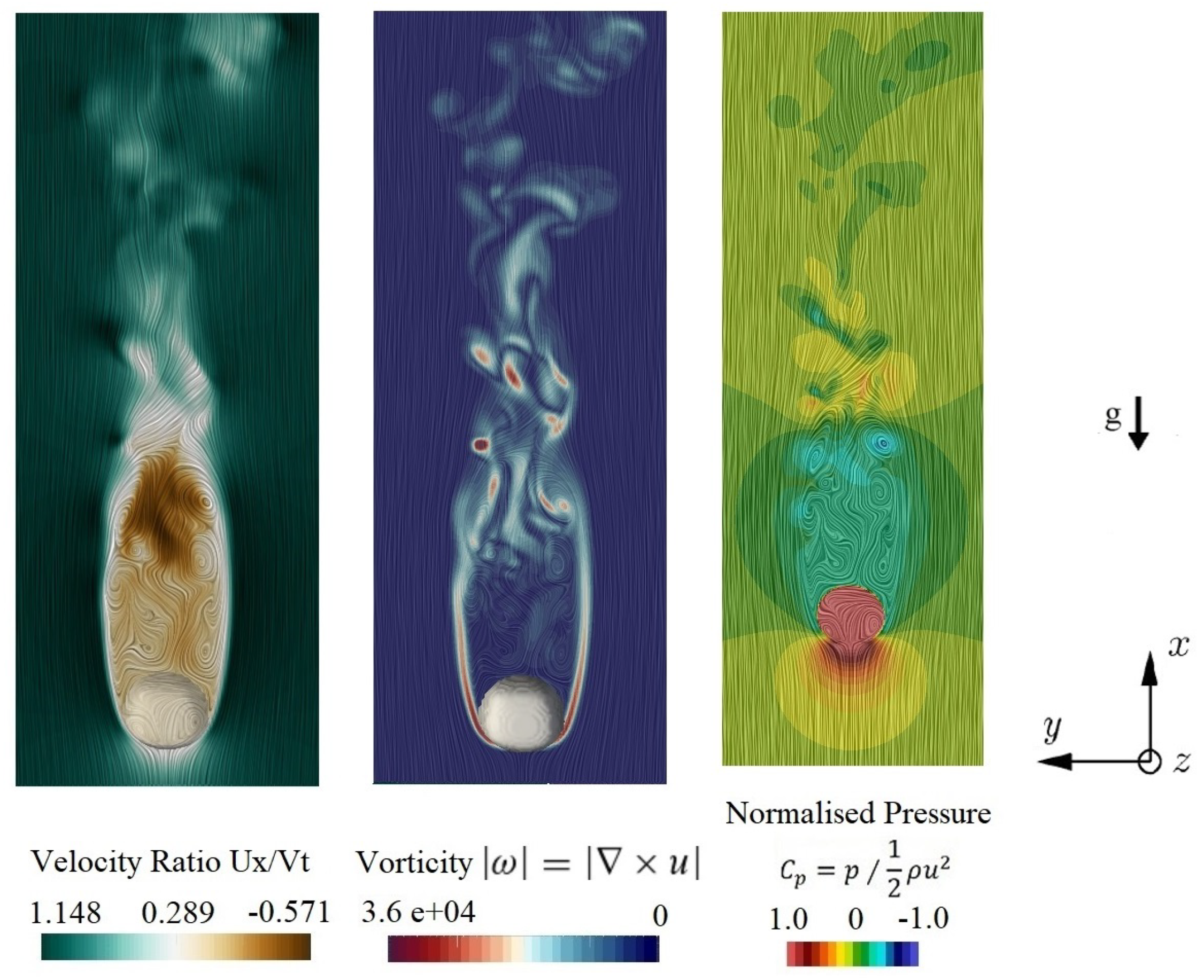
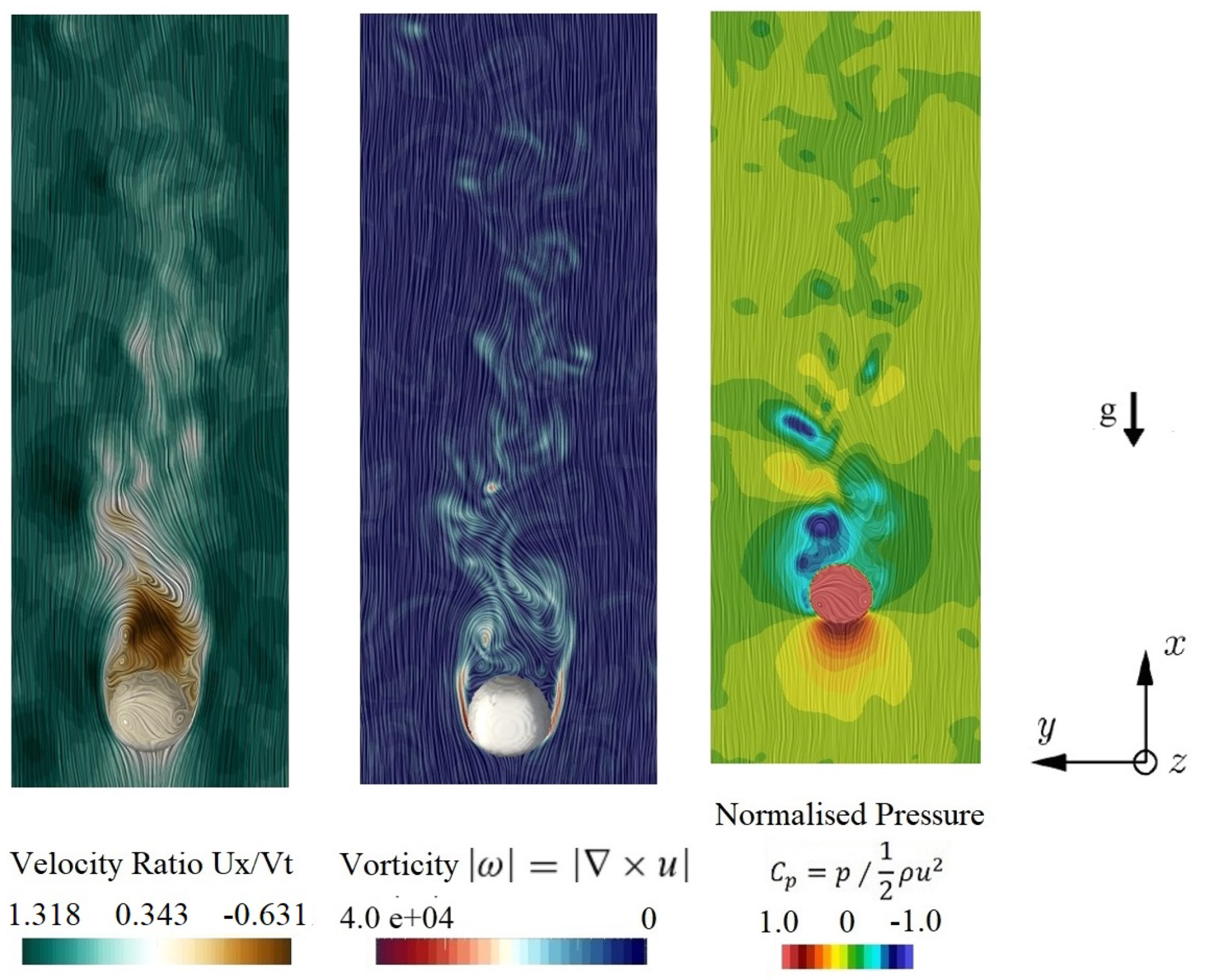
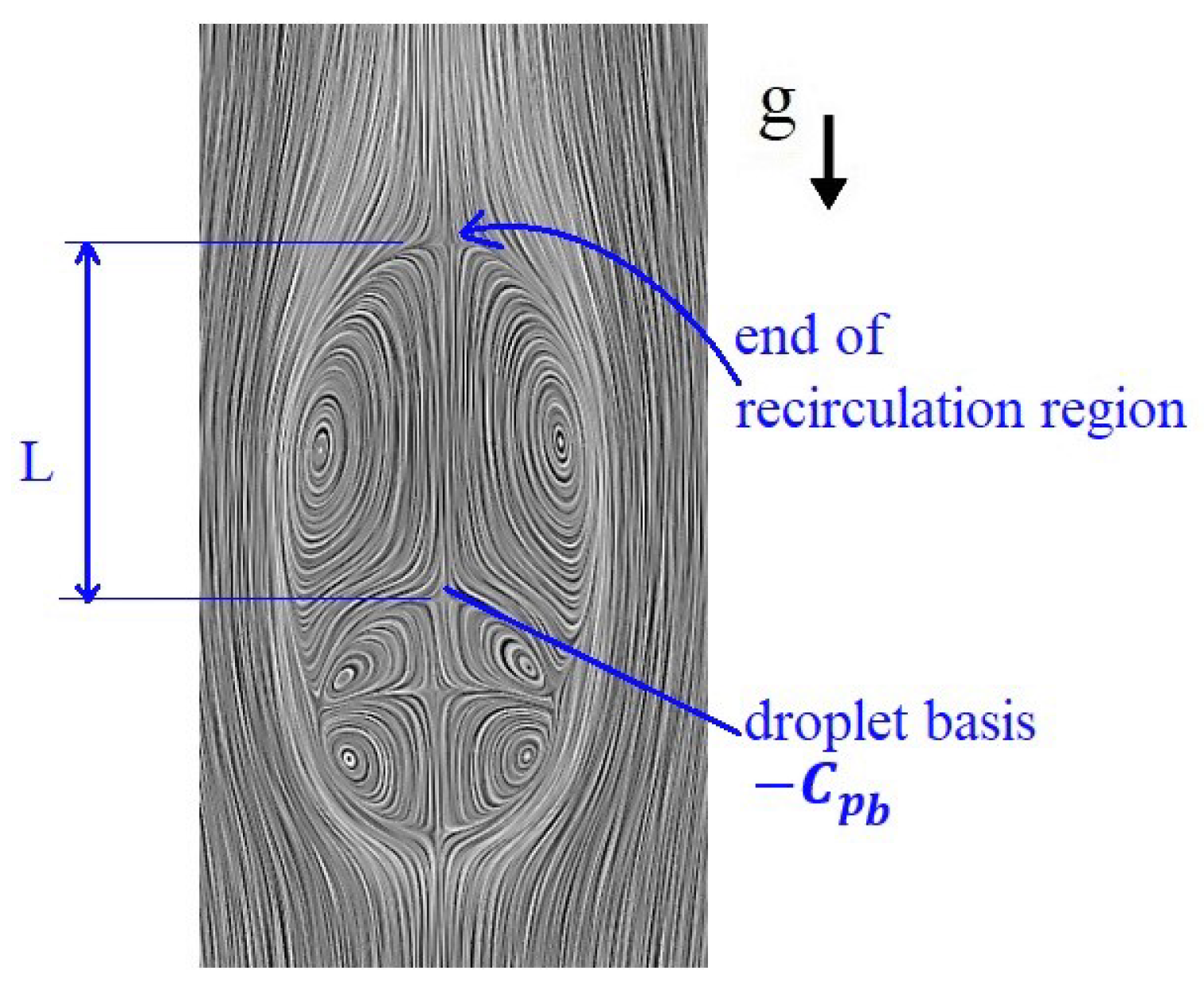
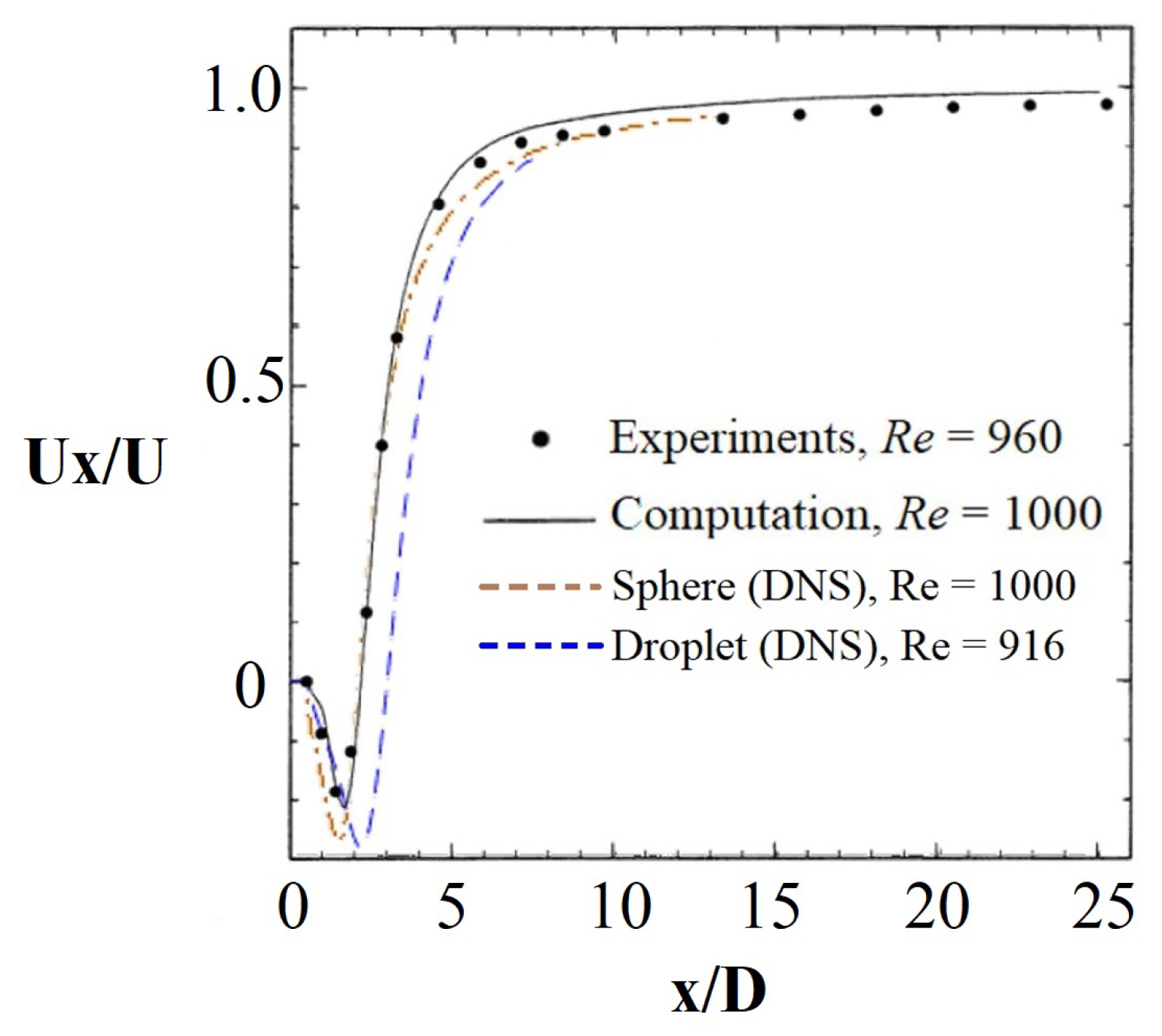
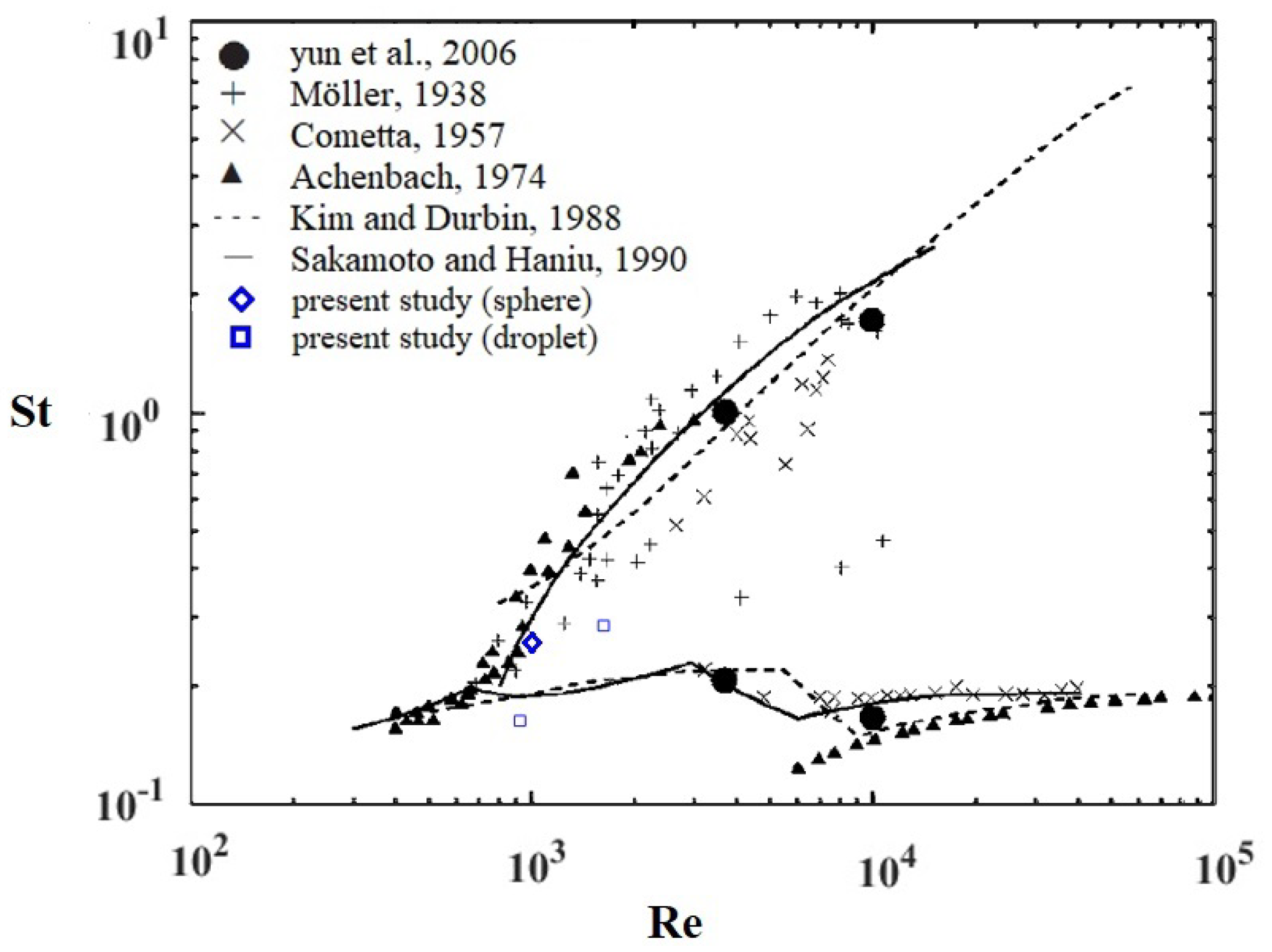
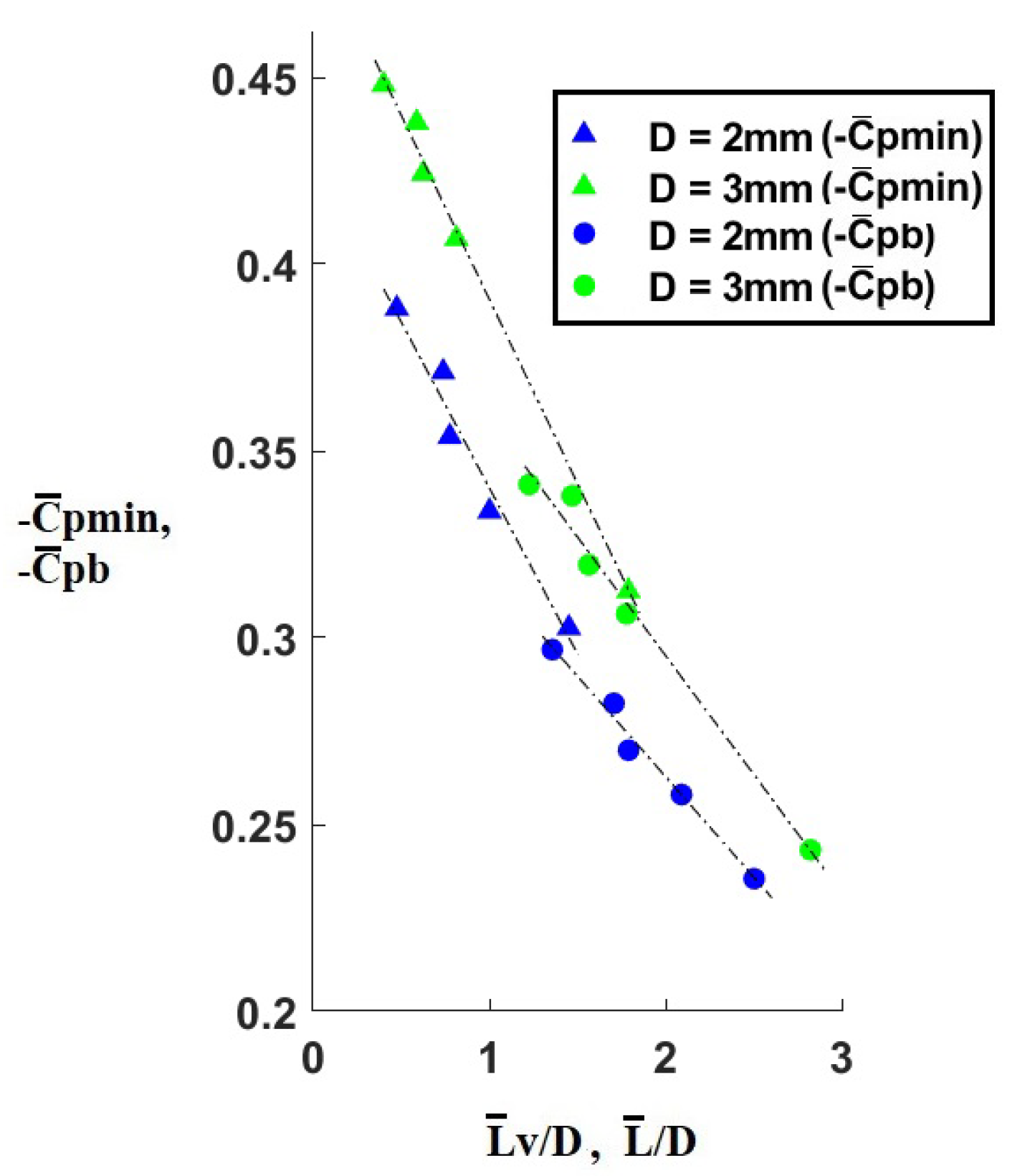
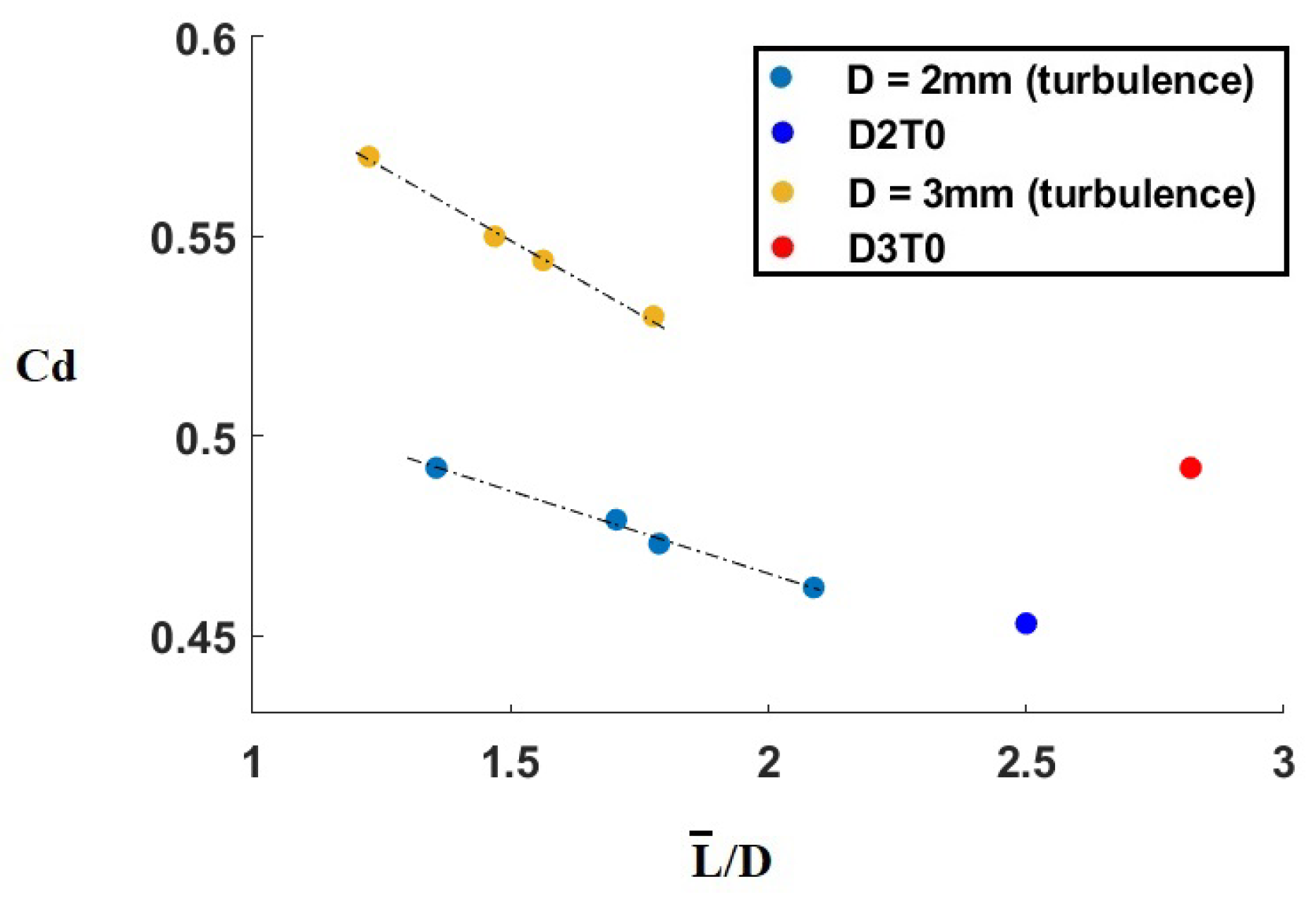
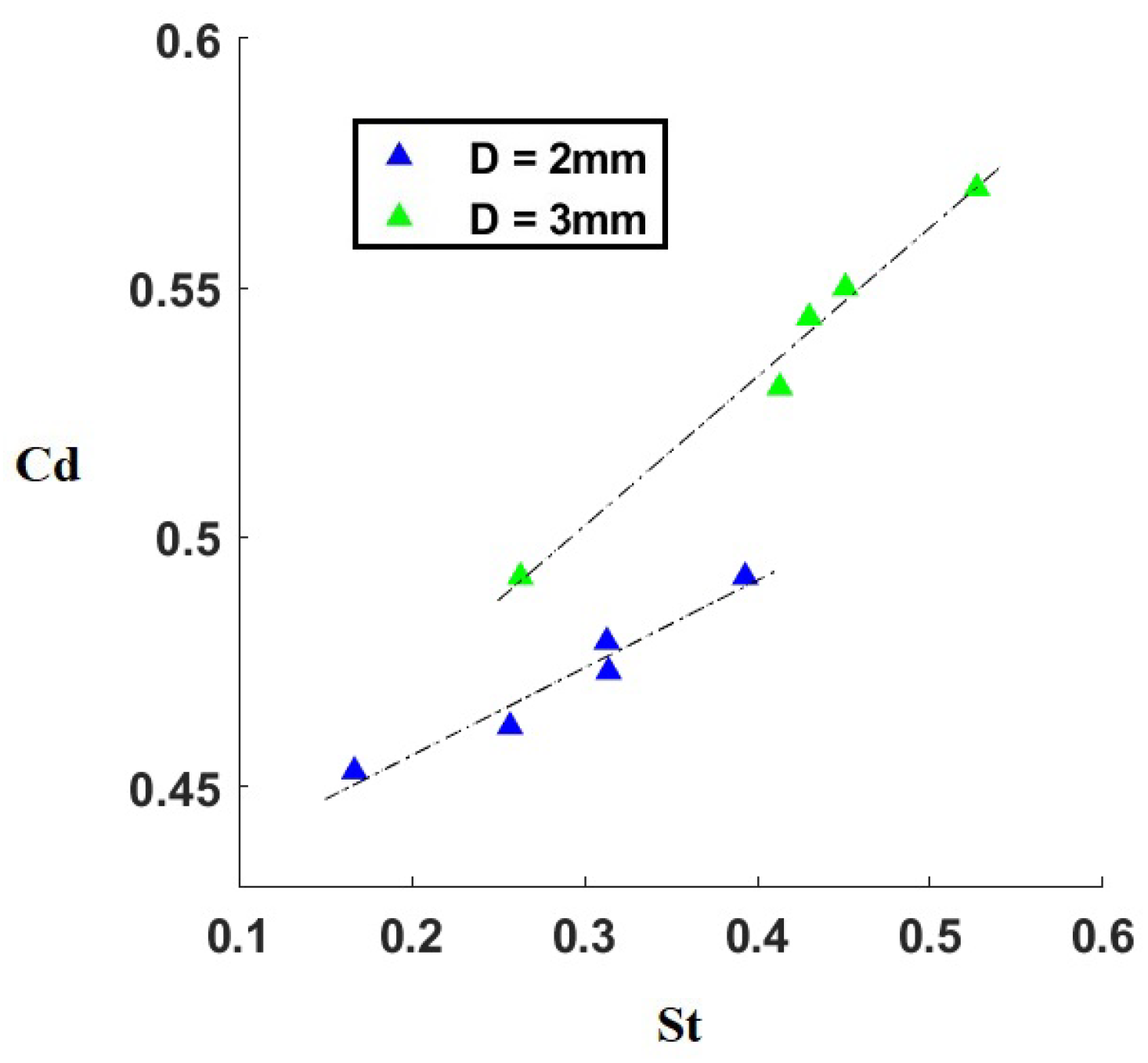
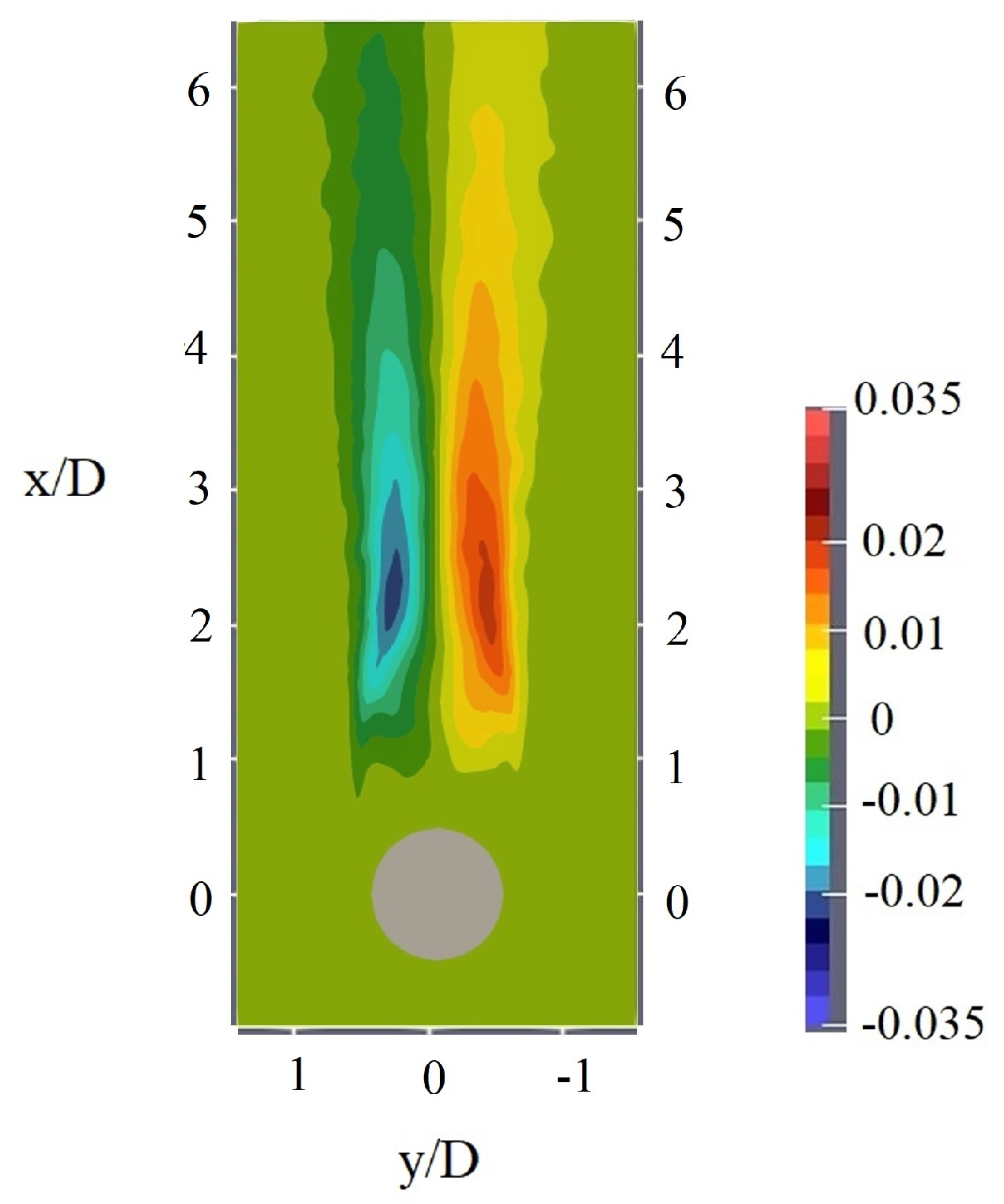

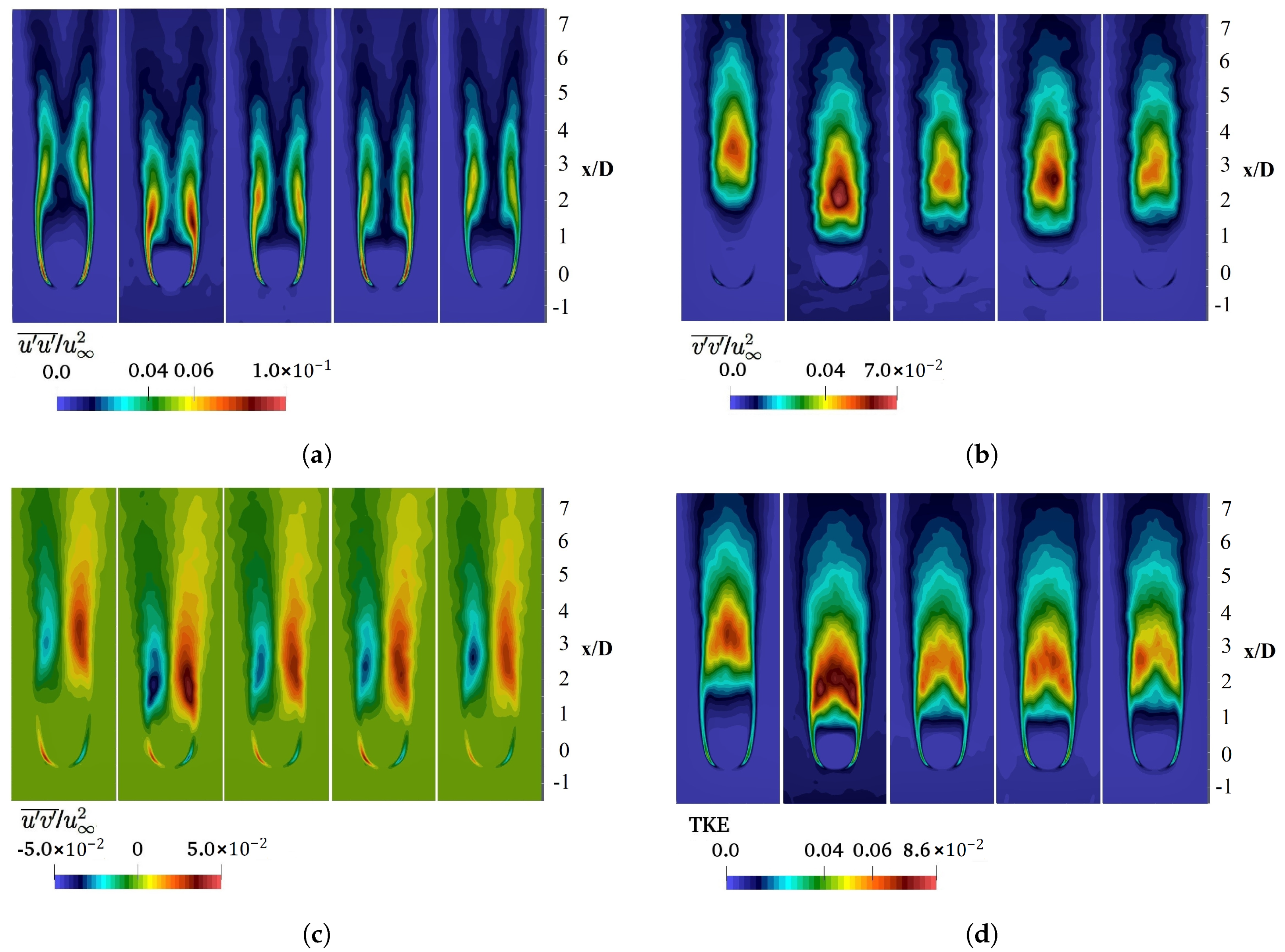
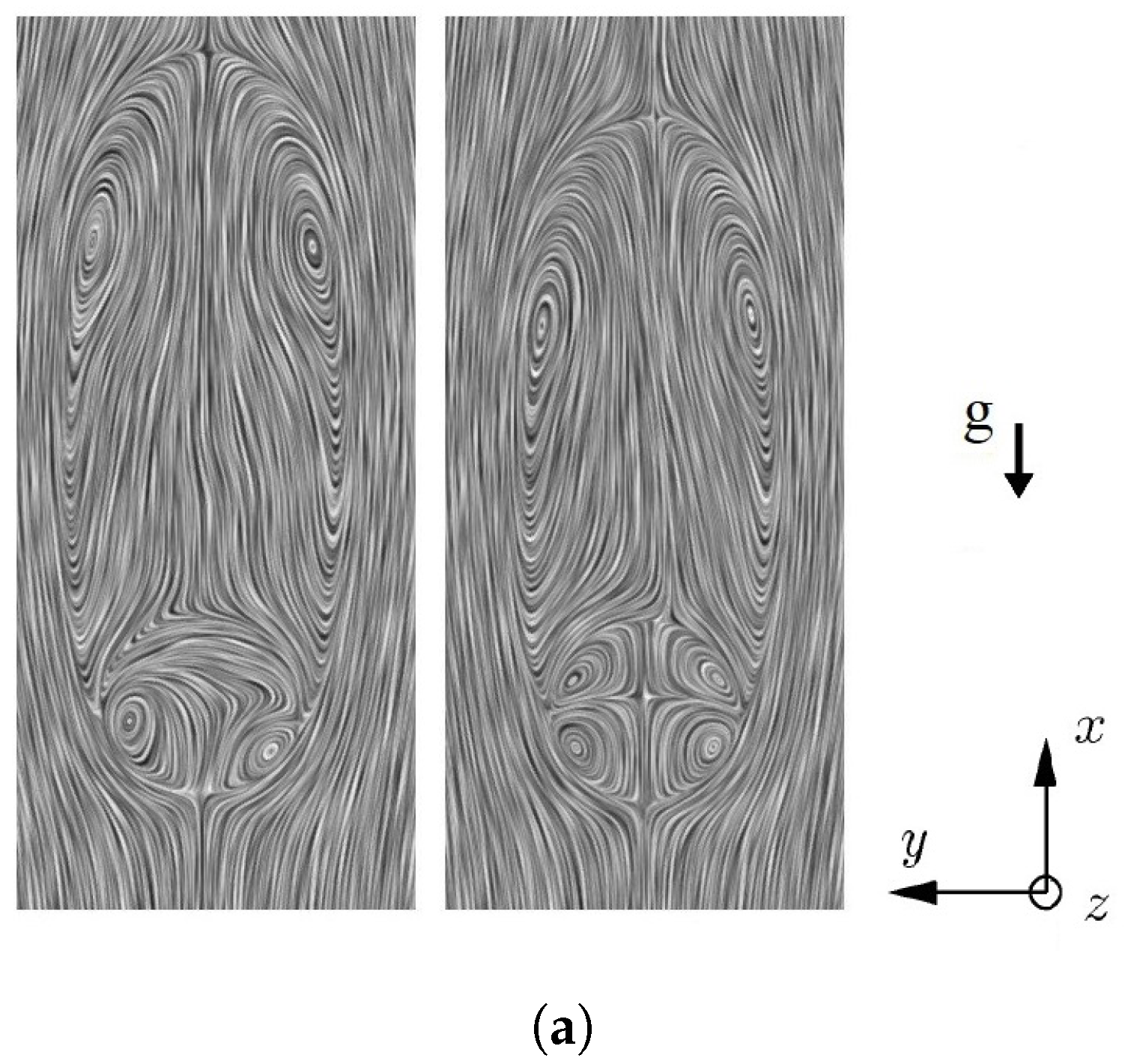
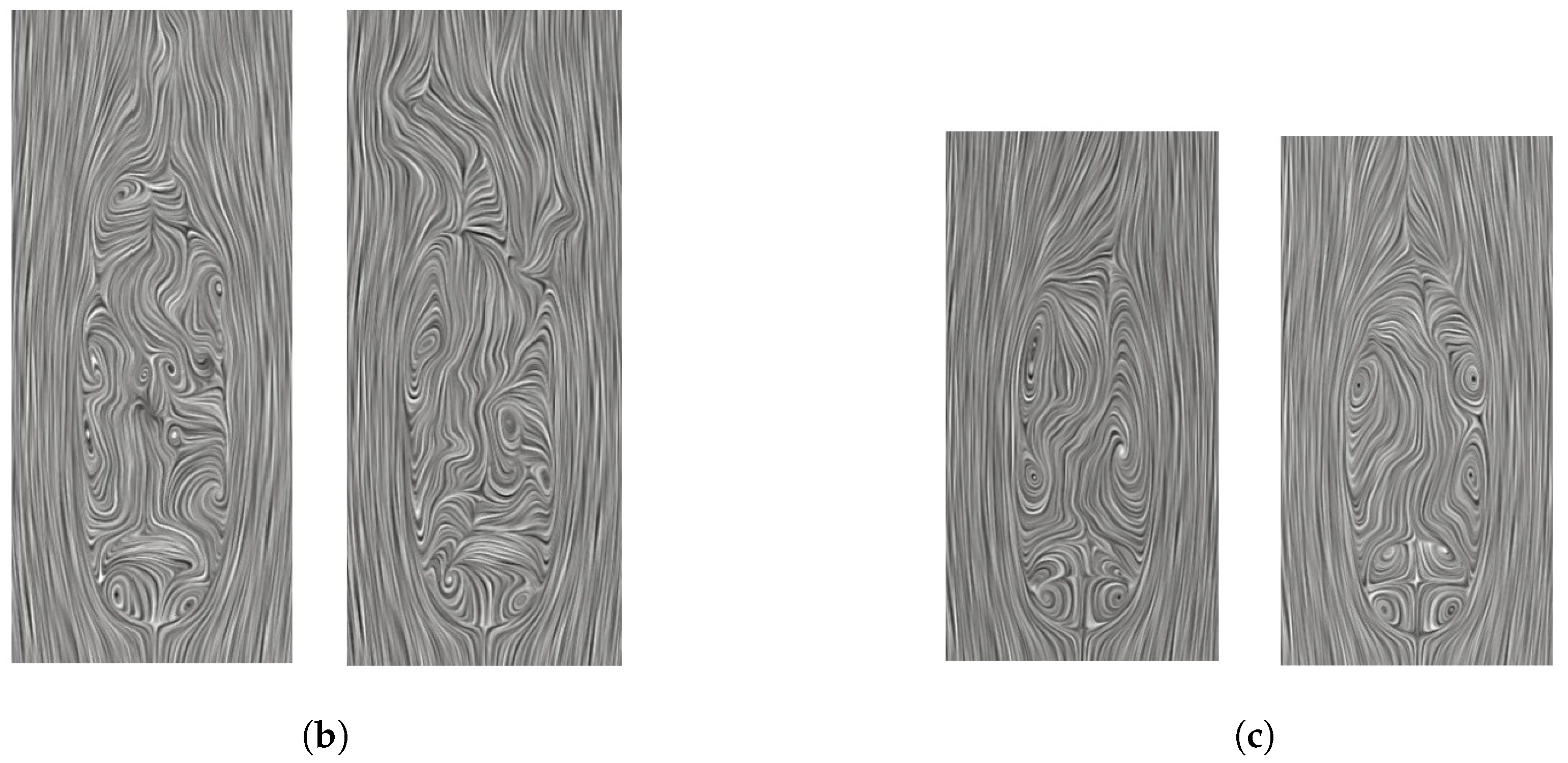
| Air Density gas (kg/m) | Water Density l (kg/m) | Air Viscosity gas (Pas) | Water Viscosity l (Pas) | Surface Tension (N/m) |
|---|---|---|---|---|
| 1.2045 | 998.2 | 18.2 × 10 | 1 × 10 | 72.75 × 10 |
| Equivalent Drop Diameter (mm) | Terminal Velocity (m/s) | Reynolds Number | Drag Coefficient |
|---|---|---|---|
| 3.0 | 8.06 | 1613 | 0.503 |
| 2.0 | 6.49 | 866 | 0.517 |
| Test Cases | Terminal Velocity (m/s) | Drag Coefficient | Velocity Decrease | Reynolds Number | Weber Number |
|---|---|---|---|---|---|
| D3T0 | 8.13 | 0.492 | - | 1614 | 3.28 |
| D3L050T10 | 7.55 | 0.570 | 7.1% | - | - |
| D3L025T10 | 7.73 | 0.544 | 4.9% | - | - |
| D3L050T05 | 7.69 | 0.550 | 5.4% | - | - |
| D3L025T05 | 7.83 | 0.530 | 3.7% | - | - |
| D2T0 | 6.92 | 0.453 | - | 916 | 1.59 |
| D2L050T10 | 6.64 | 0.492 | 4.0% | - | - |
| D2L025T10 | 6.77 | 0.473 | 2.2% | - | - |
| D2L050T05 | 6.73 | 0.479 | 2.7% | - | - |
| D2L025T05 | 6.85 | 0.462 | 1.0% | - | - |
| Test Cases | Axis Ratio | Axis Length 2 (mm) | Axis Ratio Amplitude | Oscillation Frequency |
|---|---|---|---|---|
| D3T0 | 0.881 | 3.119 | 0.086 | 59 |
| D3L050T10 | 0.887 | 3.114 | 0.144 | 66 |
| D3L025T10 | 0.886 | 3.115 | 0.091 | 62 |
| D3L050T05 | 0.887 | 3.114 | 0.088 | 60 |
| D3L025T05 | 0.884 | 3.117 | 0.107 | 61 |
| D2T0 | 0.942 | 2.040 | 0.064 | 116 |
| D2L050T10 | 0.942 | 2.038 | 0.098 | 120 |
| D2L025T10 | 0.942 | 2.038 | 0.067 | 116 |
| D2L050T05 | 0.942 | 2.040 | 0.083 | 116 |
| D2L025T05 | 0.942 | 2.039 | 0.075 | 117 |
| − | − | |||||
|---|---|---|---|---|---|---|
| D3T0 | 88.2 | 0.243 | 2.82 | 0.313 | 1.787 | 0.263 |
| D3L050T10 | 93.6 | 0.341 | 1.23 | 0.448 | 0.400 | 0.532 |
| D3L025T10 | 92.3 | 0.320 | 1.56 | 0.424 | 0.625 | 0.430 |
| D3L050T05 | 95.1 | 0.338 | 1.47 | 0.438 | 0.588 | 0.451 |
| D3L025T05 | 88.7 | 0.306 | 1.78 | 0.407 | 0.813 | 0.413 |
| D2T0 | 90.6 | 0.236 | 2.50 | 0.303 | 1.450 | 0.167 |
| D2L050T10 | 96.0 | 0.297 | 1.36 | 0.388 | 0.475 | 0.393 |
| D2L025T10 | 92.2 | 0.270 | 1.79 | 0.354 | 0.775 | 0.314 |
| D2L050T05 | 93.7 | 0.282 | 1.71 | 0.371 | 0.738 | 0.313 |
| D2L025T05 | 90.8 | 0.258 | 2.09 | 0.334 | 1.000 | 0.257 |
© 2020 by the authors. Licensee MDPI, Basel, Switzerland. This article is an open access article distributed under the terms and conditions of the Creative Commons Attribution (CC BY) license (http://creativecommons.org/licenses/by/4.0/).
Share and Cite
Ren, W.; Reutzsch, J.; Weigand, B. Direct Numerical Simulation of Water Droplets in Turbulent Flow. Fluids 2020, 5, 158. https://doi.org/10.3390/fluids5030158
Ren W, Reutzsch J, Weigand B. Direct Numerical Simulation of Water Droplets in Turbulent Flow. Fluids. 2020; 5(3):158. https://doi.org/10.3390/fluids5030158
Chicago/Turabian StyleRen, Weibo, Jonathan Reutzsch, and Bernhard Weigand. 2020. "Direct Numerical Simulation of Water Droplets in Turbulent Flow" Fluids 5, no. 3: 158. https://doi.org/10.3390/fluids5030158
APA StyleRen, W., Reutzsch, J., & Weigand, B. (2020). Direct Numerical Simulation of Water Droplets in Turbulent Flow. Fluids, 5(3), 158. https://doi.org/10.3390/fluids5030158




